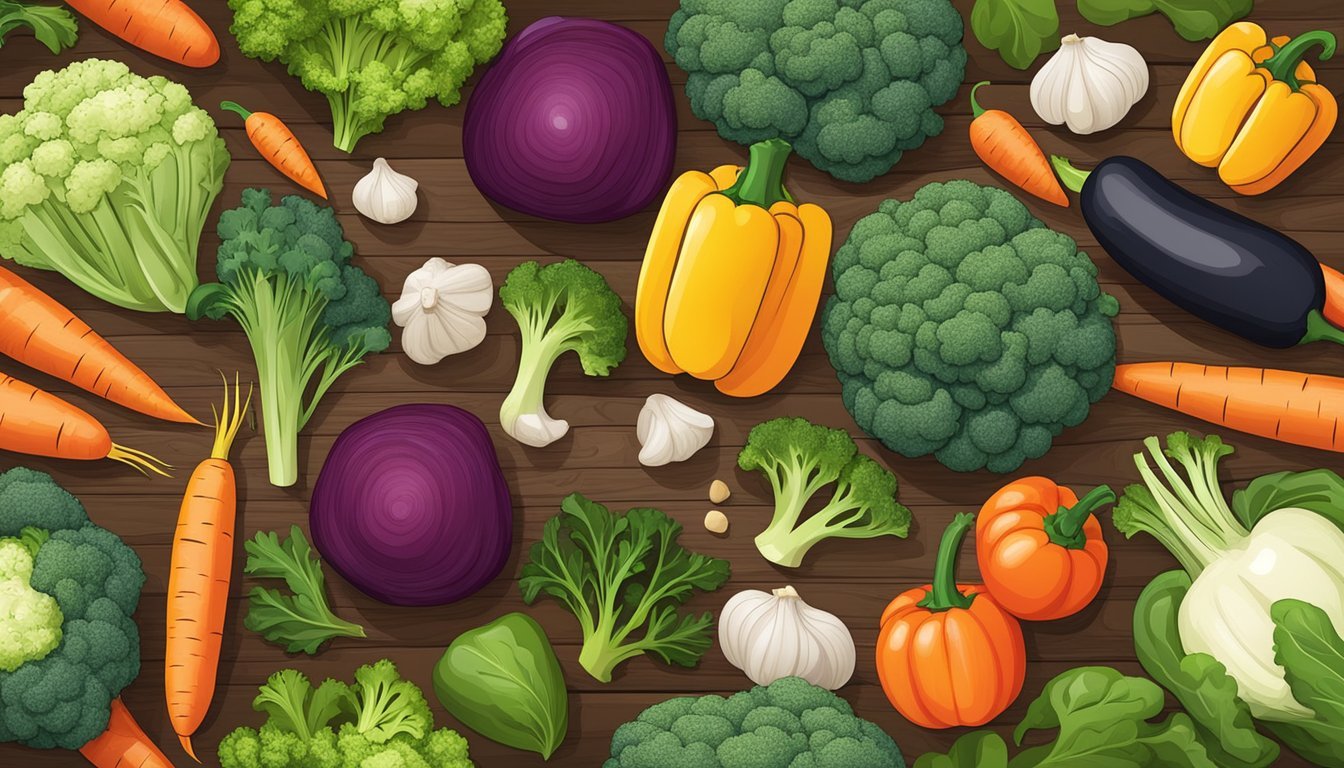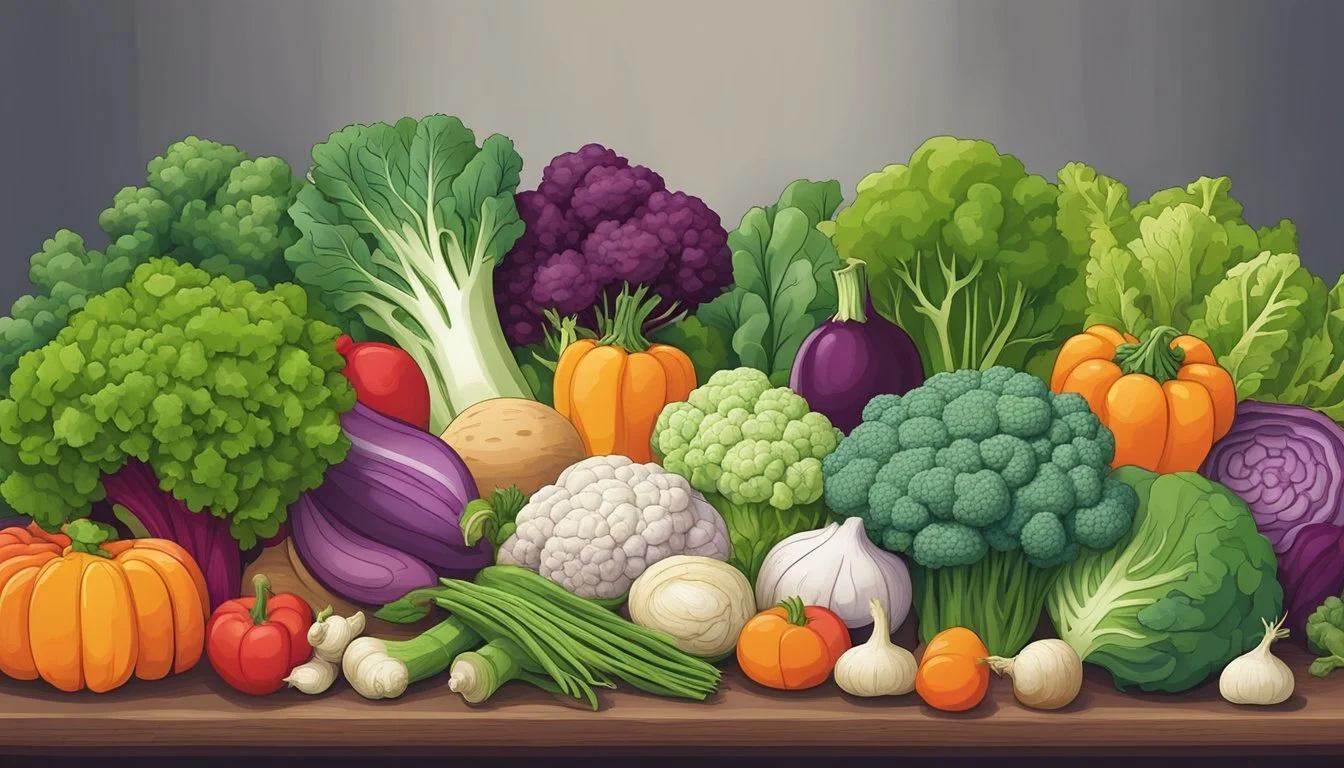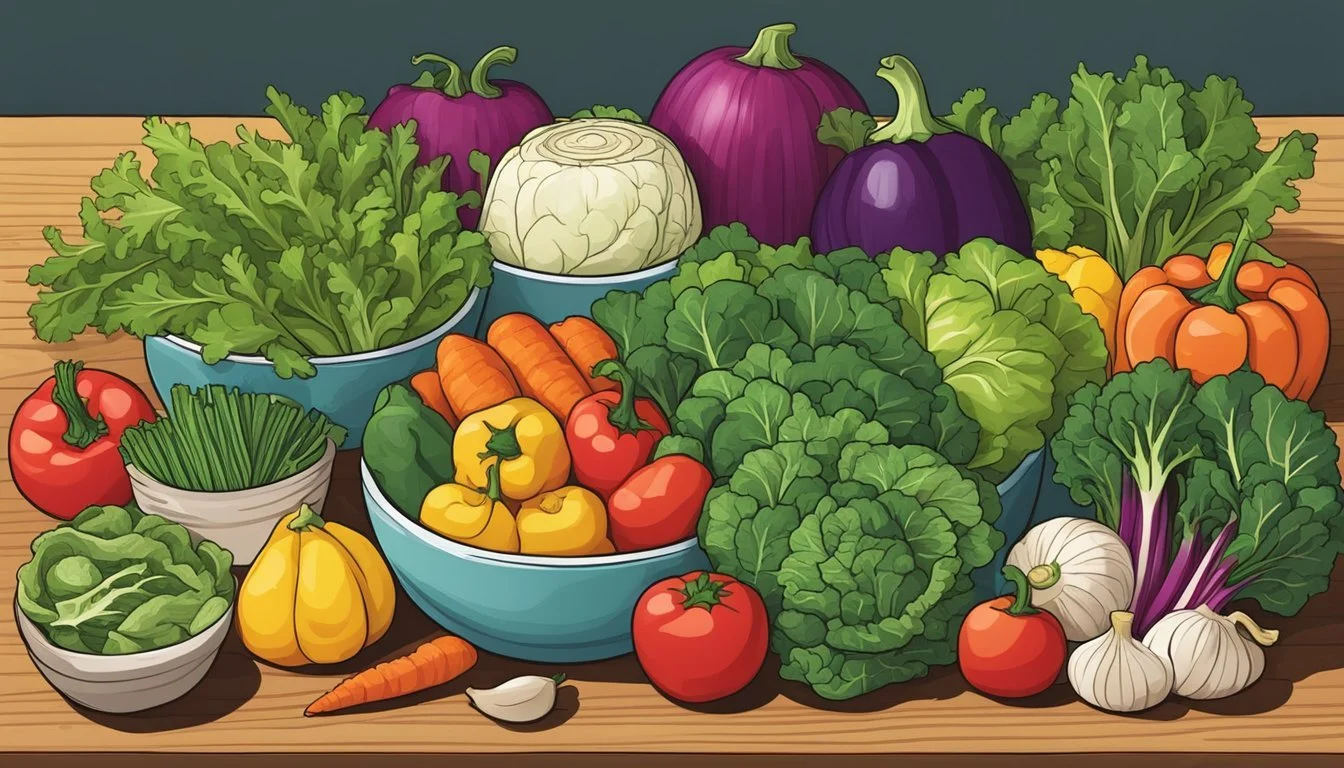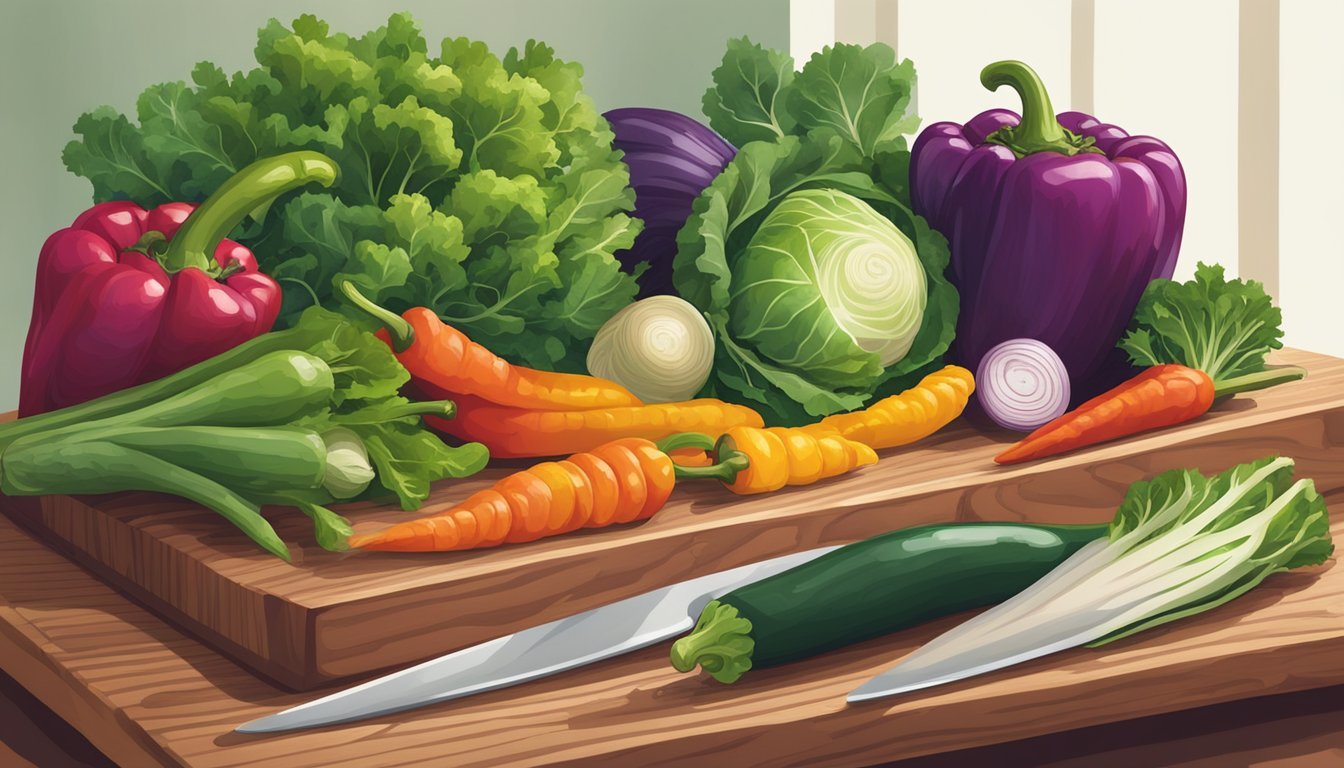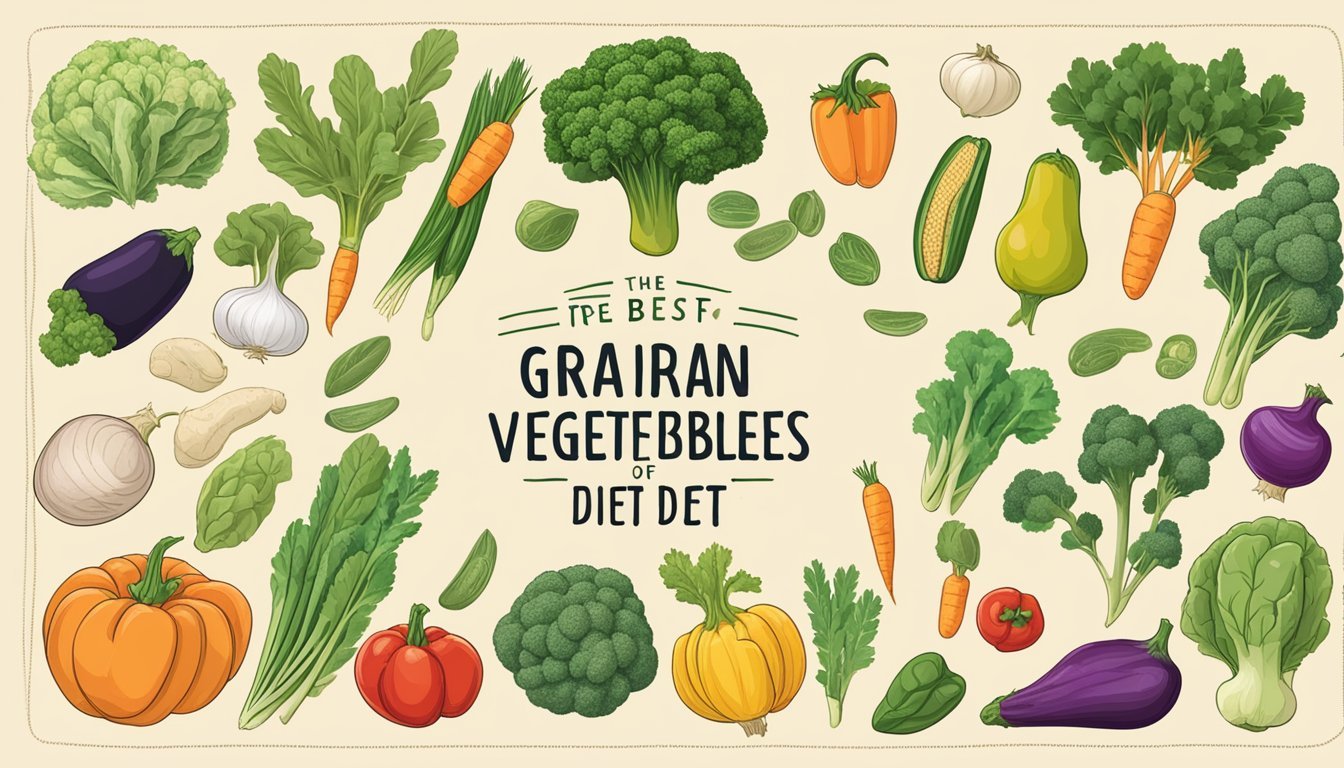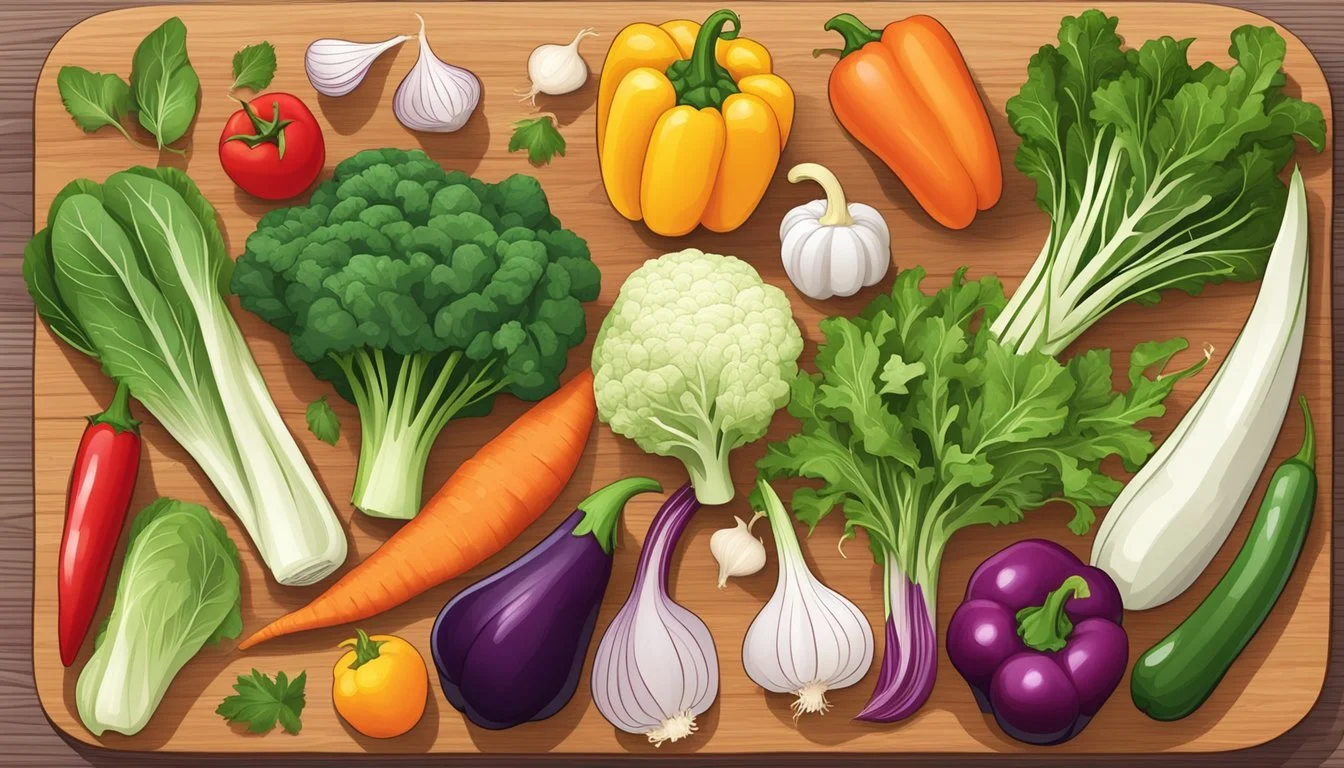The Best Seasonal Vegetables for a Grain-Free Diet
Optimal Choices for Health and Flavor
A grain-free diet eliminates all grains, including wheat, corn, rice, and oats, which are staple ingredients in many diets. This dietary choice can be motivated by a variety of factors, including gluten sensitivities, celiac disease, or personal preferences for a low-carbohydrate lifestyle. By focusing on vegetables, the diet emphasizes whole, unprocessed foods that are rich in nutrients and inherently gluten-free. Such a diet can contribute positively to one's health by reducing the intake of processed foods and increasing the consumption of fiber, vitamins, and minerals.
Seasonal vegetables play a crucial role in a grain-free diet as they provide variety, flavor, and nutritional benefits throughout the year. Opting for seasonal produce ensures that individuals are getting vegetables at their peak freshness and nutrient density. Additionally, seasonal vegetables often require fewer resources to grow and transport, making them a more sustainable choice. With careful planning, a grain-free diet enriched with a rotation of seasonal vegetables can support overall health while also keeping meals exciting and diverse.
Exploring the best seasonal vegetables for a grain-free diet offers a delightful journey into flavorful and health-conscious culinary experiences, catering to a variety of dietary needs and preferences. Whether individuals are planning for a grain-free barbecue picnic, seeking options for a grain-free vegan lifestyle, or exploring alternatives due to grain-free diabetes, these vegetables provide a versatile and nutritious solution for a grain-free lifestyle.
For those incorporating grain-free pasta alternatives into their meals or delving into grain-free baking, seasonal vegetables can serve as a delicious and wholesome addition to recipes, enhancing the culinary experience. Additionally, for individuals seeking a satisfying and convenient way to fuel an active lifestyle, the incorporation of seasonal vegetables can ensure they have the necessary sustenance for their dietary needs.
These vegetables are a testament to the diversity and adaptability of a grain-free diet, contributing to inspiring grain-free success stories and promoting overall well-being. Embracing the best seasonal vegetables for a grain-free diet offers a fulfilling and health-conscious approach to nourishment, ensuring that individuals can enjoy flavorful and nourishing meals tailored to their specific dietary requirements.
Understanding Grain-Free Diets
In the context of dietary choices, a grain-free diet excludes all grains and grain-derived products. It often aligns with the goals of managing certain health conditions and pursuing specific health benefits.
Defining Grain-Free
A grain-free diet eliminates all forms of grains, including but not limited to wheat, rice, oats, barley, and rye. It transcends a gluten-free diet by excluding whole grains like quinoa and buckwheat, which are naturally gluten-free. This dietary approach is not only about removing gluten, found in wheat, barley, and rye, but also about avoiding all grain-based products such as flours and pastas, regardless of their gluten content.
Benefits of Removing Grains
Among the potential benefits of a grain-free diet are improved blood sugar control and possible weight loss. For individuals with autoimmune diseases such as celiac disease or non-celiac gluten sensitivity, avoiding grain can reduce inflammation. The diet may be chosen to improve gut health and, as some suggest, could have a positive impact on mental health. However, it is crucial to approach these claims critically, as benefits can vary greatly from person to person.
Common Misconceptions
One prevalent misconception is that 'grain-free' is synonymous with 'healthier', which is not necessarily accurate. A balanced approach to nutrition is vital, and grains can be part of a healthy diet. Removing grains does not guarantee weight loss or improved health and could result in missing out on the benefits of whole grains, such as fiber and essential vitamins. It is also a myth that everyone should follow a grain-free or gluten-free diet; these are primarily beneficial for individuals with specific medical conditions, such as celiac disease, diabetes, or non-celiac gluten sensitivity.
The shift to a grain-free diet should be carefully considered, and one may consult with a healthcare provider or dietician to ensure nutritional needs are met.
Fundamental Principles of a Grain-Free Diet
Adopting a grain-free diet involves focusing on whole, unprocessed foods while eliminating all grains, which are sources of carbohydrates and gluten. This approach emphasizes the consumption of meat, eggs, nuts, seeds, fruits, and vegetables, providing a diversity of nutrients from naturally gluten-free food groups.
Foods to Include
Protein-rich Foods:
Meat: Opt for grass-fed, organic, and lean cuts where possible.
Fish: Include a variety of fish, such as salmon, trout, and sardines, which are also high in omega-3 fatty acids.
Eggs: A staple in grain-free diets for their protein and versatility.
Plant-based Nutrients:
Seeds and Nuts: A wide array, including almonds, chia seeds, flaxseeds, and walnuts.
Legumes: Beans, lentils, and chickpeas serve as excellent plant protein sources.
Fruits and Vegetables: Emphasize leafy greens and other colorful, fiber-rich fruits and vegetables.
Dairy:
Cheese and Yogurt: Opt for full-fat and minimally processed varieties where possible.
Foods to Avoid
Grains and Gluten-containing Foods:
Wheat: Including wheat-based bread, pasta, and cereals.
Corn: Often found in processed foods and syrups.
Rice, Oats, Barley, Rye: Common gluten-containing grains.
Pasta and Bread: Typically made from wheat, they are to be excluded.
Triticale: A less common hybrid of wheat and rye that contains gluten.
Processed Foods:
Any food product that contains grains or grain-derived ingredients should be avoided. This includes snacks, sweets, and processed meat products that may contain fillers like breadcrumbs.
By eliminating grains and focusing on whole foods, individuals on a grain-free diet must seek nutrient-dense alternatives to meet their dietary needs, often leading to an increased intake of vegetables and protein sources.
Optimal Seasonal Vegetables for Grain-Free Living
For individuals following a grain-free diet, selecting vegetables that align with the season ensures the produce is not only fresh but also at its nutritional peak. Here, you'll find a curated list of optimal seasonal vegetables that offer a variety of vitamins, minerals, and fiber to support digestion and overall health.
Spring Vegetables
Spring welcomes a burst of growth, making it an ideal time to add leafy greens and cruciferous vegetables to one's diet. These vegetables are high in fiber and rich in nutrients.
Spinach: Packed with iron and folate, perfect for salads or smoothies.
Broccoli (how long does broccoli last?): High in vitamin C and K, excellent steamed or roasted.
Summer Vegetables
Summer provides an abundance of heat-loving plants that add variety and flavor to grain-free meals.
Tomatoes: Rich in vitamin C and antioxidants, versatile in many dishes.
Zucchini: Offers dietary fiber and is ideal grilled or spiralized.
Autumn Vegetables
Autumn's harvest brings a plethora of root vegetables and hearty choices suitable for cooler weather.
Pumpkin: A good source of vitamins A and E, ideal for soups and purees.
Sweet potatoes: Provide beta-carotene and are less starchy compared to other tubers.
Winter Vegetables
Winter's selection may be more limited, but root vegetables and certain greens thrive in the cooler months.
Kale: Dense in nutrients and can withstand frosty temperatures.
Carrots: Offer beta-carotene and can be roasted or used in stews.
Incorporating Healthy Fats and Proteins
Achieving nutritional balance on a grain-free diet relies on selecting quality proteins and choosing healthful fats. This practice supports muscle maintenance, bone health, and overall energy levels.
Selecting Quality Proteins
When incorporating proteins into a grain-free diet, it's essential to emphasize variety and quality. Animal-based proteins like meat, fish, and seafood provide all essential amino acids and are highly bioavailable sources for the body.
Meat: Opt for grass-fed and organic options where possible to ensure higher omega-3 content and fewer additives.
Fish and Seafood: Fatty fish such as salmon and mackerel are rich in omega-3 fatty acids. Wild-caught choices are often more sustainable and less exposed to toxins compared to farmed varieties.
Eggs: They are a complete protein and contain vital nutrients such as choline. Free-range eggs tend to have a higher nutrient profile.
For plant-based protein sources, nuts and seeds are excellent options:
Nuts: Almonds, walnuts, and pistachios are nutrient-dense choices, providing both protein and fiber.
Seeds: Chia seeds, flaxseeds, and hemp seeds are not only high in protein but also contain beneficial fats and fiber.
Choosing Healthful Fats
Fats play a critical role in a grain-free diet both for satiety and to absorb fat-soluble vitamins.
Avocado: A versatile fruit that is high in monounsaturated fats and can be included in salads, smoothies, or as a topping.
Olive oil: Rich in antioxidants and monounsaturated fats, olive oil is ideal for dressings and low-heat cooking.
Coconut oil: It has a higher smoke point and can be used for baking and sautéing, but it's high in saturated fat, so moderation is key.
In addition to these, nuts and seeds also contribute healthful fats that are essential for brain health and inflammation regulation. Regularly incorporating a mix of these fats into meals can substantially benefit one's overall health on a grain-free diet.
Beyond Vegetables: Complementary Foods and Substitutes
This section explores the assortment of foods that complement a grain-free diet, focusing on fruits, seeds, legumes, and flour made without grains, which provide diversity and nutritional benefits to meals.
Fruit Pairings
Fruits can be a refreshing pairing with vegetables in a grain-free diet, offering vitamins, minerals, and fiber. Citrus fruits like oranges and grapefruits, are high in vitamin C and pair well with leafy greens in salads. Berries, such as strawberries and blueberries, provide antioxidants and are a sweet addition to any dish.
Nutrient-Dense Seeds and Nuts
Seeds and nuts are an excellent source of healthy fats, proteins, and various micronutrients.
Seeds: Flax, chia, and hemp seeds are rich in omega-3 fatty acids and can be sprinkled onto salads and vegetables.
Nuts: Almonds, walnuts, and Brazil nuts offer a satisfying crunch and are packed with proteins and healthy fats.
Legume Alternatives
Legumes are high in protein and fiber, making them a substantial substitute within a grain-free diet. Lentils and chickpeas can be used in place of grains to create hearty meals. They also provide important minerals such as iron and magnesium. Edamame and black beans are versatile, grain-free legume options that are equally nutritious.
Grain-Free Flour Options
Flour alternatives made from nuts and other grain-free sources provide versatility in a grain-free kitchen.
Nut Flours: Almond flour and coconut flour are popular for baking, providing a gluten-free, grain-free base for recipes.
Pseudocereals: Buckwheat, quinoa, amaranth, millet, and sorghum are not true grains but provide similar textures and are used to make grain-free bread, pancakes, and other dishes.
Vegetable Alternatives: Zucchini noodles are a popular substitute for traditional pasta, offering a lighter, nutrient-packed option for grain-free meals.
Managing Carbohydrates and Sugars on a Grain-Free Diet
Adopting a grain-free diet requires careful consideration of carbohydrates and sugars, as grains are often a primary source of carbs in many diets. Here's how an individual can manage carbs and sugars efficiently while focusing on the best seasonal vegetables.
Understanding Carbohydrates
Carbohydrates are a vital energy source, but in a grain-free diet, they must come from alternative sources. Vegetables such as sweet potatoes and squashes can be excellent substitutes, providing necessary nutrients without grains. Legumes, although higher in carbohydrates, also offer protein and fiber. Monitoring intake to maintain stable blood sugar levels is critical—overconsumption can lead to spikes, whereas underconsumption may result in low energy.
Natural Sugars in Vegetables and Fruits
Vegetables and fruits contain natural sugars, which unlike added sugars, come with essential vitamins, minerals, and fiber. Seasonal vegetables like beets (how long do beets last?) and carrots have naturally occurring sugars that can satisfy a sweet tooth. Fruit choices, while more sugary, should be moderated; berries, for instance, offer sweetness with lower sugar content than tropical fruits.
Common Vegetables and Their Sugar Content:
Vegetable Sugars per 100g Beets 6.76g Carrots 4.74g Spinach 0.42g Broccoli 1.70g
Consumers should be aware that though these are healthier, they still affect blood sugar and should be balanced with other macronutrients.
Grain-Free Sweeteners
For those looking to sweeten their meals without grains or added sugars, honey, stevia, and monk fruit offer natural alternatives. Honey, while natural, is high in sugar and should be used sparingly. Stevia and monk fruit are much sweeter than sugar but have little to no impact on blood sugar, making them preferred options for many on a grain-free diet.
Sweetener Comparison:
Sweetener Caloric Content Impact on Blood Sugar Honey High Moderate Stevia None Low Monk Fruit None Low
The selection of the right sweeteners and understanding the sugar content in vegetables can help manage carbohydrates and sustain a balanced, grain-free diet.
Meal Planning and Recipes for a Grain-Free Diet
When adopting a grain-free diet, it's crucial to incorporate a diverse range of nutrient-dense foods that can replace grains without compromising on taste or satisfaction. The following meal ideas emphasize the use of seasonal vegetables, high-quality proteins, and healthy fats to create balanced and flavorful dishes.
Breakfast Options
For a grain-free breakfast, one might favor eggs as a high-quality source of protein. An omelet with spinach, mushrooms, and cherry tomatoes can provide a vegetable-packed start to the day. Alternatively, smoothies can be a quick option, blending leafy greens such as kale or spinach with berries, a handful of nuts, and a scoop of protein powder for a dairy-free, gluten-free morning boost.
Lunch Ideas
Lunches on a grain-free diet can be both satisfying and simple. Salads are versatile; for example, one could combine mixed greens, sliced avocado, grilled chicken, and a sprinkle of seeds for a meal rich in nutrients and flavor. Another option could be cabbage or lettuce wraps, filled with stir-fried peppers, carrots, and a protein of choice like shrimp or tofu, for a crunchy and refreshing midday meal.
Dinner Solutions
Dinners can capitalize on heartier vegetables and proteins to feel fulfilling without grains. One might prepare a stir-fry with a medley of seasonal vegetables such as broccoli, bell peppers, and zucchini, tossing them with slices of beef or tempeh in a savory sauce. Another comforting option can be soups, with a base of homemade bone broth, mixed with diced vegetables and chunks of chicken or fish, seasoned with herbs and spices to enhance the natural flavors.
Snacks and Treats
For snacks, one should consider foods that are both nourishing and convenient. Nuts and seeds are excellent for on-the-go snacking and provide a good balance of healthy fats and protein. As for treats, fruit served with a dollop of coconut cream can satisfy a sweet craving, offering a gluten-free, dairy-free alternative to traditional desserts.
Addressing Nutritional Concerns
When individuals adopt a grain-free diet, they might worry about obtaining certain nutrients typically abundant in grains. This section covers how to ensure adequate intake of fiber, vitamins, and minerals through seasonal vegetables.
Ensuring Adequate Fiber Intake
Fiber plays a crucial role in digestive health and can be less abundant in a grain-free diet. To compensate for the lack of grains, one should focus on high-fiber vegetables. For instance:
Root vegetables: like carrots and beets are dense in fiber.
Leafy greens: such as kale and swiss chard offer a good amount of fiber.
Cruciferous vegetables: including broccoli and Brussels sprouts (how long do brussels sprouts last?), have high fiber content.
A daily serving of these vegetables helps maintain fiber intake for good digestive function.
Getting Enough Vitamins and Minerals
Grains are often fortified with vitamins and minerals, so removing them from the diet necessitates other sources. Vegetables are rich in an array of micro-nutrients:
Vitamins: A diversity of vegetables can supply the body with essential vitamins. Dark, leafy greens provide vitamin K, essential for blood clotting and bone health. Bell peppers are high in vitamin C, important for immune function.
Minerals: Spinach and other greens are excellent sources of magnesium and manganese, vital for bone health and enzyme functions.
Incorporating a variety of colorful seasonal vegetables ensures a diet rich in B vitamins and trace minerals, which support mental health and overall well-being. Aim for a mix of vegetables to cover the spectrum of plant-based nutrients required for a balanced diet.
The Intersection of Grain-Free Diet and Health Conditions
Adopting a grain-free diet can influence various health conditions, particularly those related to the digestive system, immune responses, and metabolic processes. By eliminating grains, some individuals may notice improvements in specific health issues, while others may choose to avoid grains to manage chronic conditions.
Digestive Health
Grains can be problematic for some individuals causing digestive issues such as bloating, constipation, and discomfort. A grain-free diet might alleviate these symptoms, especially for those with celiac disease or non-celiac gluten sensitivity, as they cannot tolerate gluten, a protein found in wheat, barley, and rye. Switching to a gluten-free, grain-free diet is the primary treatment for people with celiac disease, and it can substantially reduce symptoms and promote intestinal healing.
Chronic Inflammation and Autoimmunity
Chronic inflammation is a common underlying factor in many autoimmune diseases. Consuming grains, particularly gluten-containing grains, may exacerbate inflammatory responses in susceptible individuals. Conditions like rheumatoid arthritis or inflammatory bowel disease (IBD) often see symptomatic relief from a grain-free or gluten-free diet. It's also observed that people with autoimmune diseases might benefit from such dietary adjustments as they can potentially reduce autoimmunity triggers.
Metabolic and Endocrine Disorders
Individuals with metabolic syndrome, diabetes, and other related endocrine disorders may find that a grain-free diet helps in regulating blood sugar levels and improving metabolic outcomes. By focusing on vegetables, proteins, and healthy fats over grains, patients often experience more stable blood glucose control and better overall health management. For some conditions like fibromyalgia and endometriosis, which can be associated with metabolic dysfunctions, a grain-free diet has been reported to help in reducing pain and managing symptoms.
Lifestyle and Sustainability Considerations
When adopting a grain-free diet, individuals must consider the sustainability of their food choices along with the economic implications. These considerations ensure that the dietary shift aligns with both personal health goals and environmental stewardship.
Balancing Cost and Access to Specialty Ingredients
A grain-free diet often relies on less common ingredients that may be more costly or harder to find in standard grocery stores. Seasonal vegetables are a cornerstone of this diet, offering nutrient density without the need for grains. However, individuals should be aware that:
Specialty foods, such as almond flour or coconut aminos often used in paleo or keto recipes, can significantly increase the grocery bill.
Local farmers' markets or community-supported agriculture can provide seasonal produce at a lower cost compared to specialty stores.
Environmental Impact of a Grain-Free Diet
A grain-free diet, especially when it includes a high intake of animal products as in some paleo or keto plans, comes with a notable environmental footprint. To mitigate this, one can:
Embrace diet sustainability by choosing a higher ratio of plant-based foods within the grain-free framework.
Opt for locally-sourced and organically farmed produce to support sustainable agricultural practices.
Incorporate seasonal eating habits, which often involve less resource-intensive transport and storage, reducing the carbon footprint associated with food consumption.
By considering these factors, those on a grain-free diet can make informed decisions that support both their health and the health of the planet.
The Downsides of Grain-Free Diets
Restrictive Eating: A grain-free diet removes all grain products, which can be highly restrictive. Individuals may find this diet difficult to maintain long-term due to the limitation of dietary choices, especially when dining out or attending social events.
Nutrient Deficiency Risks: Grains are a significant source of essential nutrients like B vitamins, iron, and dietary fiber. Eliminating grains might lead to deficiencies unless carefully replaced by other foods.
Fiber deficiency: Without whole grains, individuals might struggle to consume enough dietary fiber, which is vital for digestive health.
B vitamins: Whole grains are rich in B vitamins, crucial for energy production and brain function.
Processed Grain-Free Products: The market offers an array of processed grain-free products such as gluten-free pastries and crackers. These items are often high in sugar, unhealthy fats, and preservatives, negating the potential health benefits of a whole food-based grain-free diet.
Social and Psychological Impacts: Adhering to a grain-free regimen can be socially isolating and psychologically challenging. Individuals may feel left out during communal meals and may experience stress or anxiety from constant dietary monitoring.
To mitigate these downsides, it's important for individuals to plan their diets carefully and seek guidance from a nutrition expert. They should ensure a well-balanced intake of nutrients from other food groups and remain vigilant about potential hidden sources of grains in various products.
Conclusion
Incorporating seasonal vegetables into a grain-free diet capitalizes on the pinnacle of freshness and nutrient density these foods offer. Individuals committed to grain-free living have a diverse selection from nature's bounty that aligns with their wellness objectives. By focusing on whole foods, they ensure that their meals are rich in the vitamins, minerals, and fiber essential for optimal health.
The health benefits of this approach are manifold. They include the potential for improved digestive health, reduced inflammation, and a more personalized nutrition profile that can be tailored to individual needs and sensitivities. Embracing a variety of seasonal vegetables helps to keep the diet balanced and interesting, which can contribute significantly to long-term adherence and success.
When planning meals, consider the following:
Spring: Asparagus, spinach, and radishes
Summer: Bell peppers, cucumbers, and tomatoes
Fall: Pumpkin, squash, and brussels sprouts
Winter: Kale, carrots, and beets
It is critical to remember that a grain-free diet does not necessitate a compromise on flavor or nutrition. Instead, it offers an opportunity to explore a rich array of whole food options that can contribute to overall well-being. Individuals should consult with healthcare providers to ensure their dietary choices align with their health status and goals. This personalized approach underscores the importance of crafting a diet that is as unique as the individual, leveraging the best of each season's offerings.

